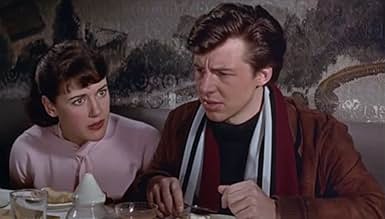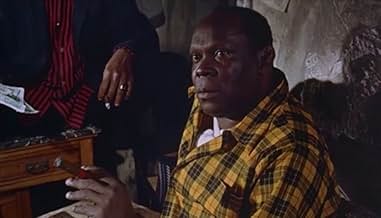IMDb-BEWERTUNG
7,2/10
2780
IHRE BEWERTUNG
Der mord an einer jungen frau in London offenbart die tiefen rassenspannungen und vorurteile in dieser gegend.Der mord an einer jungen frau in London offenbart die tiefen rassenspannungen und vorurteile in dieser gegend.Der mord an einer jungen frau in London offenbart die tiefen rassenspannungen und vorurteile in dieser gegend.
- Regie
- Drehbuch
- Hauptbesetzung
- 1 BAFTA Award gewonnen
- 3 Gewinne & 4 Nominierungen insgesamt
Thomas Baptiste
- Man on the Street
- (Nicht genannt)
Victor Brooks
- Police Sergeant
- (Nicht genannt)
Marie Burke
- Second landlady
- (Nicht genannt)
Empfohlene Bewertungen
SAPPHIRE (UK 1959) takes a honest and brutally realistic approach to racism: it exists in everyone, white, black or of mixed race. Sadly, that continues to be the case today even if now intermarriage is more acceptable and no longer prevents people renting accommodation, joining creches or schools, and it is less visibly frowned upon.
Director Basil Dearden had already distinguished himself with social comment films as THE BLUE LAMP (UK 1950), in which Dirk Bogarde plays an unrepentant criminal hunted by police in postwar London, THE SQUARE RING (UK 1953), which does not pull any punches analyzing the brutality of boxing and of the people in it, and VIOLENT PLAYGROUND (UK 1958), an ongoing duel between police and an arsonist.
Pity that six decades later racism remains a problem everywhere, and the movie industry, and life in general, continues to try to address that problem with the mendacity of political correctness.
SAPPHIRE does well to show how limited we, the human race, are in dealing with that issue. Even policemen like Learoyd (Michael Craig) are racist at heart, so there is an institutional side to the problem, too.
Direction is very good, although it allows characterization to go over the top in some cases; color photography is outstanding; screenplay is concise and objective; and acting reflects the high competence for which British filmmaking of the 1940s-1960s period was famous for, although I thought Yvonne Mitchell a little bit too unnecessarily hysterical in the key scene in which Sapphire's dark-skinned brother handles a child's doll.
Nigel Patrick's acting is particularly praiseworthy. Detective Hazard (odd surname, nothing hazardous about his character or actions) is an extremely professional, restrained, and experienced policeman standing as the emotional stabilizer in a film of many social and racial angles. He is seldom critical, he just wants justice done regardless of who must pay.
In light of mankind's above mentioned limitations, I suppose that, however incomplete, the pursuit of justice is the best, most practical solution to the continuing problem of racism in today's society, and it is to this film's credit that it highlights it at a time when the UK was beginning to receive a large number of people of other races from its former colonies.
In some ways, SAPPHIRE is well ahead of its time, and it remains very much up to date today.
Director Basil Dearden had already distinguished himself with social comment films as THE BLUE LAMP (UK 1950), in which Dirk Bogarde plays an unrepentant criminal hunted by police in postwar London, THE SQUARE RING (UK 1953), which does not pull any punches analyzing the brutality of boxing and of the people in it, and VIOLENT PLAYGROUND (UK 1958), an ongoing duel between police and an arsonist.
Pity that six decades later racism remains a problem everywhere, and the movie industry, and life in general, continues to try to address that problem with the mendacity of political correctness.
SAPPHIRE does well to show how limited we, the human race, are in dealing with that issue. Even policemen like Learoyd (Michael Craig) are racist at heart, so there is an institutional side to the problem, too.
Direction is very good, although it allows characterization to go over the top in some cases; color photography is outstanding; screenplay is concise and objective; and acting reflects the high competence for which British filmmaking of the 1940s-1960s period was famous for, although I thought Yvonne Mitchell a little bit too unnecessarily hysterical in the key scene in which Sapphire's dark-skinned brother handles a child's doll.
Nigel Patrick's acting is particularly praiseworthy. Detective Hazard (odd surname, nothing hazardous about his character or actions) is an extremely professional, restrained, and experienced policeman standing as the emotional stabilizer in a film of many social and racial angles. He is seldom critical, he just wants justice done regardless of who must pay.
In light of mankind's above mentioned limitations, I suppose that, however incomplete, the pursuit of justice is the best, most practical solution to the continuing problem of racism in today's society, and it is to this film's credit that it highlights it at a time when the UK was beginning to receive a large number of people of other races from its former colonies.
In some ways, SAPPHIRE is well ahead of its time, and it remains very much up to date today.
10kreeper
this is one of the most underappreciated films of all times. it is a superbly acted and directed film with a very intelligent and well crafted screenplay. the "twist" is revealed just at the right moment and is not played for any exploitative reason but still resonates throughout the course of the film. i have the video of this film, which is not listed anywhere and just got the poster, that is how much i love this film. if you are looking for a stupid bang bang movie don't bother, if you're looking for a goofy feel good movie, go elsewhere, but if you appreciate well-crafted film making this is your movie.
The real problem with television broadcasting is that the better movies of the last century are held from the viewers. SAPPHIRE could be shown as a double bill with AN INSPECTOR CALLS. There are not enough movie buffs to push some of these classics so that they can be shown to today's audiences ..which would really appreciate them.
At first glance, SAPPHIRE seems to be your usual police procedural murder mystery thriller, with the superintendent and his supporting inspector (both played with bullish charm by Nigel Patrick and Michael Craig) investigating the discovery of a murdered girl in the local park. Indeed, their investigations initially take them down the usual alleyways as they explore the girl's social group, her relationship with a local lad, and some less-than-salubrious locations she was involved with.
However, where SAPPHIRE becomes something much, much more is in its context: race relations in Britain, circa 1959. It turns out that Sapphire herself was actually of mixed race, despite looking white. The discovery of her racial origins underpins the whole story and it's up to Patrick and Craig to unpin the build up to her brutal death. This is a shocking film, exploring the ugly face of racism in its matter-of-fact hatred of blacks and their creed. There's something grippingly realistic about it which makes it all the better film.
The supporting cast is very well picked. Nobody does shifty better than Paul Massie, the primary murder suspect. Earl Cameron is the model of race and refinement as the dead girl's brother. Yvonne Mitchell is superbly twitchy and Bernard Miles convincingly bigoted. Robert Adams supplies the one moment of true humour with his great cameo as Horace Big Cigar. As a film, SAPPHIRE is never less than thoroughly impressive, working well as a piece of social history as well as a fine detective story.
However, where SAPPHIRE becomes something much, much more is in its context: race relations in Britain, circa 1959. It turns out that Sapphire herself was actually of mixed race, despite looking white. The discovery of her racial origins underpins the whole story and it's up to Patrick and Craig to unpin the build up to her brutal death. This is a shocking film, exploring the ugly face of racism in its matter-of-fact hatred of blacks and their creed. There's something grippingly realistic about it which makes it all the better film.
The supporting cast is very well picked. Nobody does shifty better than Paul Massie, the primary murder suspect. Earl Cameron is the model of race and refinement as the dead girl's brother. Yvonne Mitchell is superbly twitchy and Bernard Miles convincingly bigoted. Robert Adams supplies the one moment of true humour with his great cameo as Horace Big Cigar. As a film, SAPPHIRE is never less than thoroughly impressive, working well as a piece of social history as well as a fine detective story.
I saw this movie (for the first time) when cable TV was new to Birmingham, Alabama. It was aired on a channel out of Chicago. Throughout the years, I have tried unsuccessfully to find a copy. Then...about three months ago, I found a collector with a copy in mint-condition. It has been well worth the money I spent. I watch it at least once a week. The cast worked very well together and the soundtrack is still hypnotic. The subject matter is addressed with a level of cinematic respect that makes the viewer sit up and take notice: no cursing and no lewd scenes...just raw and compelling acting. Like a bottle of old wine, Sapphire gets better and better as it ages. I'm hoping that no one will insult those of us who truly love this film by screening a cheesy re-make. That would be an insulting.
Wusstest du schon
- WissenswertesThe success of this movie, in spite of its controversial themes, encouraged Janet Green to write Teufelskreis (1961), and Basil Dearden to direct it.
- PatzerThe ripped photo used as a clue appears in two versions from the first time it's discovered. The first version shows Sapphire laughing as she dances, with her mouth open. The second shows her smiling broadly with her jaw closed.
- Zitate
[last lines]
Superintendent Robert Hazard: We didn't solve anything, Phil. We just picked up the pieces.
Top-Auswahl
Melde dich zum Bewerten an und greife auf die Watchlist für personalisierte Empfehlungen zu.
- How long is Sapphire?Powered by Alexa
Details
Box Office
- Budget
- 400.000 $ (geschätzt)
- Laufzeit1 Stunde 32 Minuten
- Seitenverhältnis
- 1.66 : 1
Zu dieser Seite beitragen
Bearbeitung vorschlagen oder fehlenden Inhalt hinzufügen
































